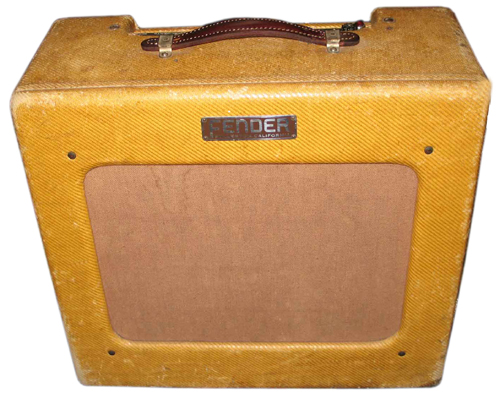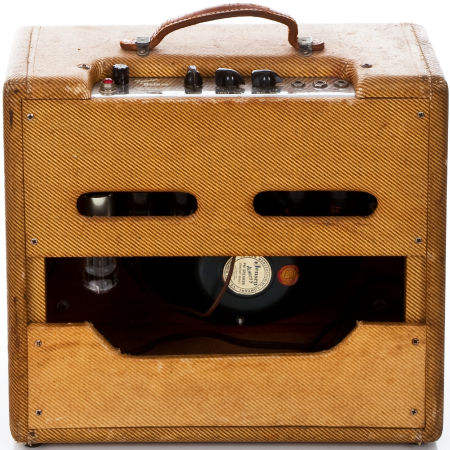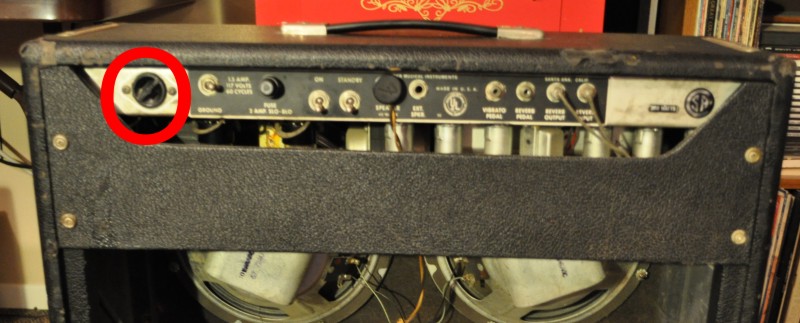 |
| 1946 Fender Model 26 |
Though Leo Fender and other amp designers of the day had a perception of their amplifiers remaining clean at high volumes, many musicians had other ideas.
The tube driven saturation of a cranked Deluxe amp was favored during the 50’s and in subsequent decades as it is still favored today.
 |
| 1947 Model 26 |
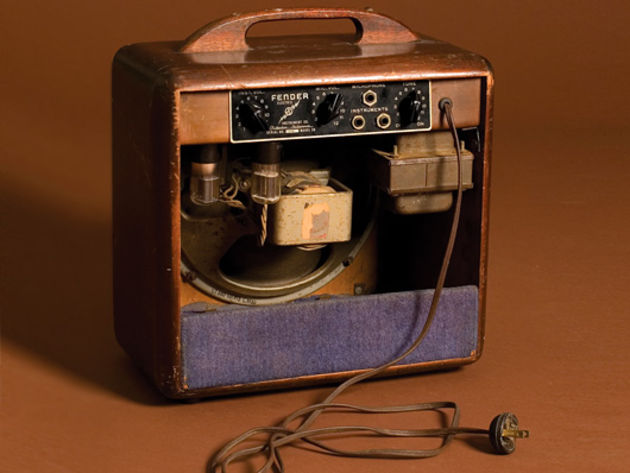 |
| 1946 Model 26 Rear |
Then beginning in 1947 Fender switched to a fixed magnetic speaker which had the output transformer mounted on the speaker basket.
The Model 26 controls were mounted on the back panel and very straight forward; an instrument volume control and a mic volume control, both of which went from 1 to 12, one mic input and two instrument inputs and a single tone potentiometer.
 |
| Metal envelope tubes |
This was a cathode biased amplifier. Cathode biasing provides a steady negative DC bias voltage on the control grid of the vacuum tubes.
I think some of the charm of the Deluxe line of Fender amps stems from the fact that they are cathode biased.
 |
| 1946 Fender Deluxe 5A3 |
Like the Model 26, the 5A3 pumped out 10 to 14 watts. However the speaker size was increased to 12” with an 8 ohm load. It was also made by the Jensen Company.
The chassis on the TV front Deluxe was made of pine and covered with tweed material made out of varnished cotton cloth. The brown colored grill was originally made of mohair in 1948, but linen cloth was used in subsequent years. Instead of wood, the handle on this model was made of leather secured with two glides.
The front of the amp had a rectangular badge proclaiming it to be Fender - Fullerton California.
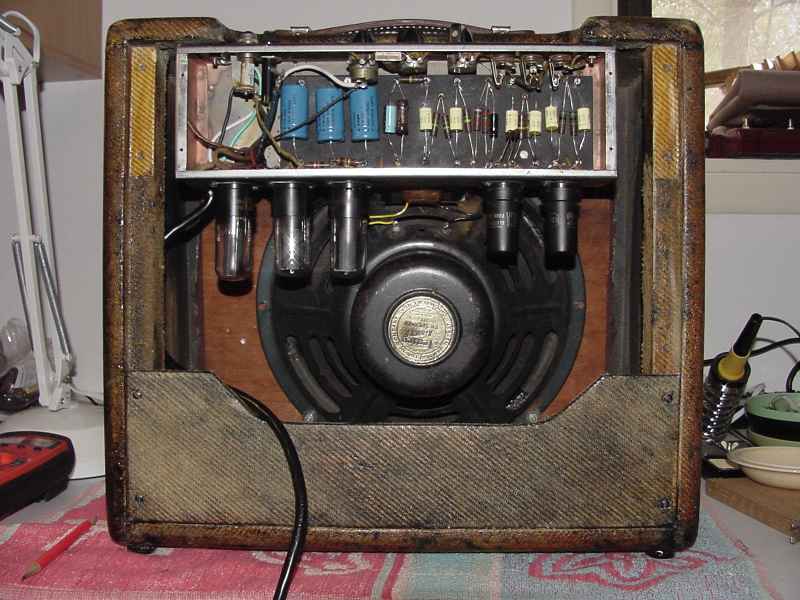 |
| 1951 Deluxe 5A3 |
 |
| 1953 Deluxe 5B3 |
Like its predecessor, this amp was covered in varnished tweed material and had a leather handle. On its front was the familiar rectangular Fender badge.
The Wide Panel Deluxe amp came with a 12” Jensen 8 ohm speaker which pumped out 10 to 14 watts.
The controls were in fact similar to the TV front version; Volume, Mic Volume, and a Tone knob that doubled as an on/off switch. This amplifier possessed two inputs labeled Instruments and one labeled Mic.
Like the model 5A3 and the model 26 the knobs were numbered 1 through 12. The grill covering on this series was dark brown linen.
The tube compliment had changed somewhat. The metal envelope tubes were now gone and instead the more modern glass tubes or GT models were utilized. Two 6V6GT’s handled the power duties. The preamp tube of choice for models 5B3 amd 5C3 were 6SC7’s and a 12AX7 for the model 5D3.
A 6SC7 was used as a phase inverter on the 5B3 and 5C3 designs, while a 12AX7 was utilized for this purpose in the model 5D3. The rectifier tube for all models was the 5Y3GT.
The model 5B3 was essentially the same amplifier as the 5A3, but for cabinet. which no longer had the "TV" front. In later years it came to be known as the Wide Panel Deluxe.
The model 5C3 included an additional on/off toggle switch, a negative feedback loop and there was a now a jack for the speaker wires which was positioned on the bottom of the amps chassis.
 |
| '55 5D3 note the badge |
As a brief explanation, a negative feedback loop flattens and extends the frequency response. This makes the sound cleaner with less distortion giving the sound a more “hi-fi” feel. The downside is that it effects the tone.
And when the amp is overdriven there is more clipping. There are advantages and disadvantages to the negative feedback loop. Something happened during the end of the run of this amplifier. For whatever reason the negative feedback loop was eliminated in the last model, the 5D3 version.
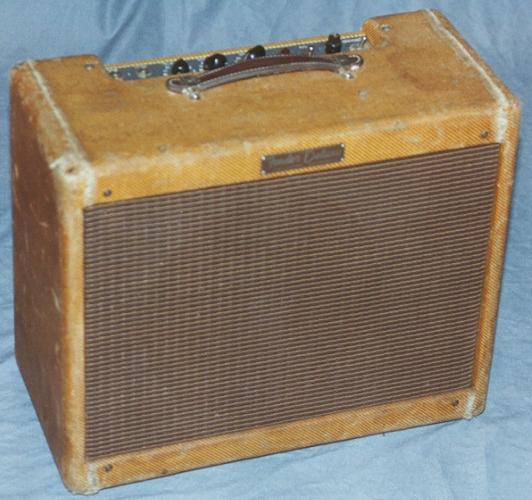 |
| 1958 Fender Deluxe 5E3 |
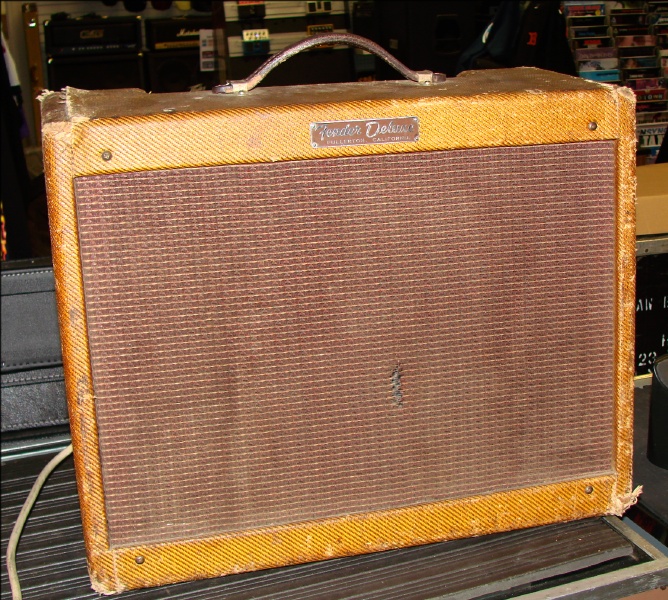 |
| 1959 Fender Deluxe 5E3 |
| 1960 Fender 5E3 |
The controls included a ground switch and a power switch, a volume potentiometer, a mic volume pontentiometer, a single tone potentiometer and two instrument inputs and two mic inputs.
A speaker and an external speaker jack were mounted on the bottom of the chassis that held the electronics.
Once again twin 6V6GT’s (glass tubes) were the choice for power tubes. The rectifier was a 5Y3GT. A 12AY7 and 1/2 of a 12AX7 were used for the preamp circuit, while the other 1/2 of the 12AX7 was utilized for phase inversion.
The rectangular badge on the amp proclaimed it to be a Fender in block letters.
Later runs of the amp came with badges that said Fender Deluxe in the same font that Fender would bein to use for years to come. The words Fullerton California were written in block lettering below.
The 53E model remained in the line-up from 1955 to 1960 and today is still a very popular and imitated model.
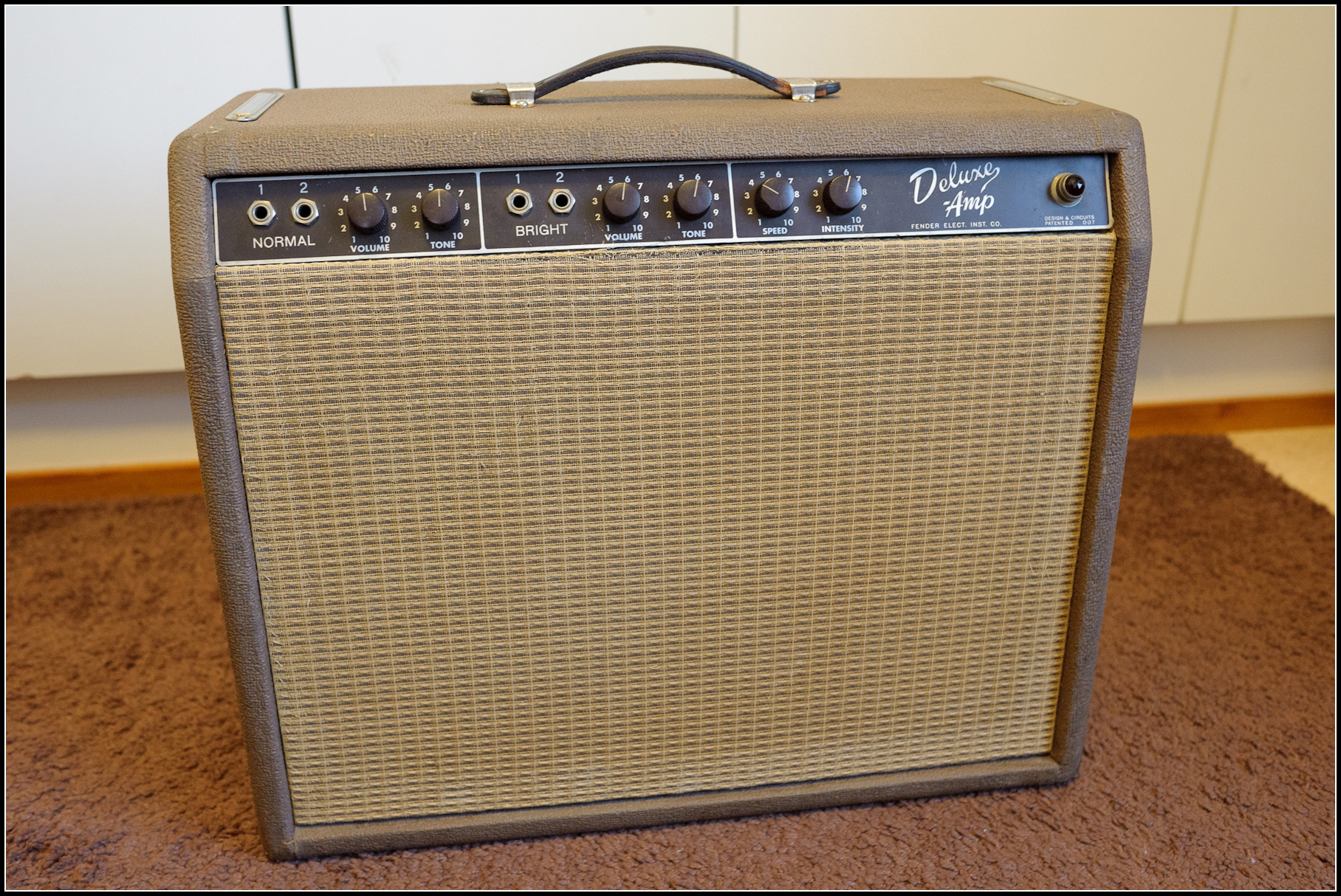 |
| 1961 Fender Deluxe 6G3 |
The amplifiers cabinet was now covered in a sandy coloured brown vinyl material called Tolex.
Tolex is a material created by the General Tire Company and was originally designed for use in upholstering the Henny-Packard (Packard was an old brand of automobiles) hearses and ambulances and in Chris Craft boats.
 |
| 1961 Fender 6G3 |
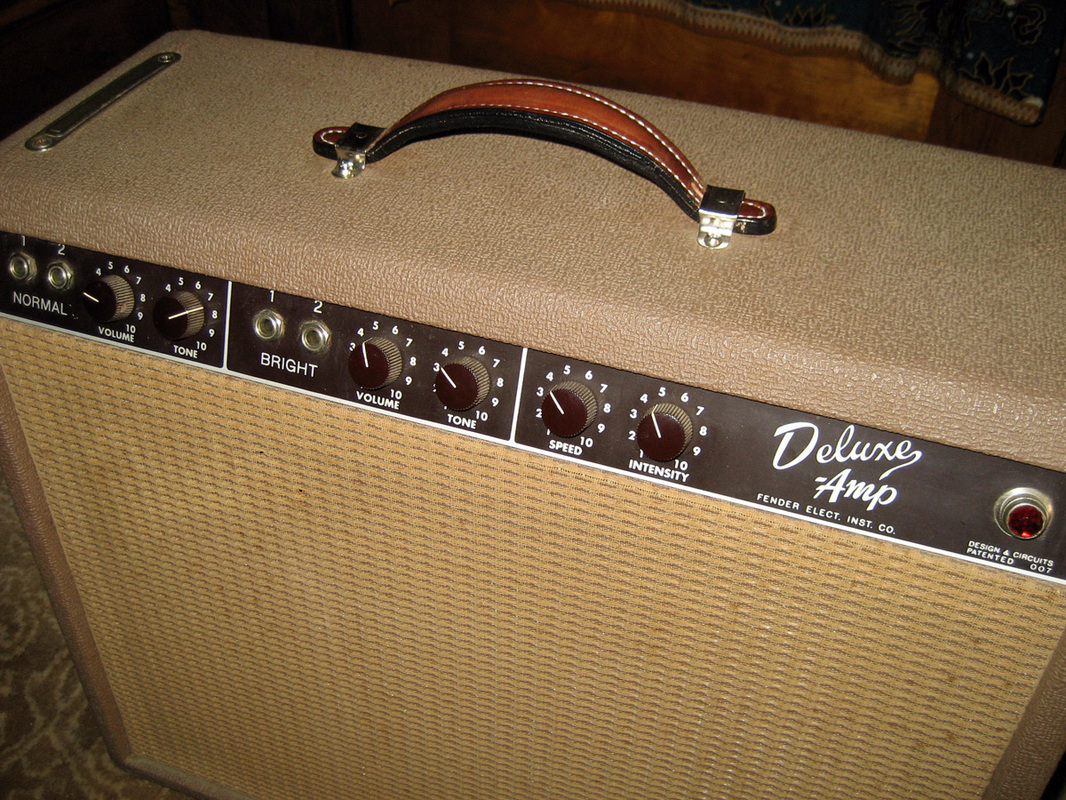 |
| 1962 Fender 6G3 |
The circuitry in this model was completely redesigned so the output was bumped up to 22 watts.
The amps speaker was 12” with an 8 ohm load, but was now made by Oxford instead of Jensen. On the earliest models the speaker screwed into the baffle from the front of the baffle board. This soon changed and the speaker screwed in from the backside.
Once again the power tubes were twin 6V6GT models. The rectifier tube was changed to a GZ34. A single 12AX7 was used as a phase inverter. The preamp section included half of a 7025 for the normal channel and the other half used for the bright channel. And as mentioned before 1/2 of a 12AX7 was used for the tremolo.
This version of the Deluxe Amp remained in the line up through 1963.
 |
| Fender Deluxe AA763 |
 |
| 1965 Fender AA763 |
I have read the second input has about a 6 db drop and can be used for humbuckers or effects pedals. I have noticed on my Fender amps the #1 input provides a bit more power.
 |
| Deluxe AA763 |
This version of the Deluxe amp pumped 22 watts into a 12” 8 ohm Oxford speaker. The power tubes were 6V6GT models.
The rectifier was a GZ34 and the preamp section was powered by two 7025 tubes. One was for the Normal channel and the other for the Vibrato/Bright channel. A 12AT7 tube was used as a phase inverter for the power tubes and a 12AX7 powered the tremolo effects. The Deluxe amp was one of the first Fender amps to include an adjustable bias potentiometer although the amp did have a fixed bias.
The controls on the back of the amp included a 2 prong “courtesy outlet”, a “ground” switch, a power switch, a standby switch, a speaker input jack, an external speaker jack and an input for the vibrato/tremolo foot pedal.
Briefly, here are a few words regarding the electric outlet found on the back of 1960’s Fender amps; This feature appeared prior to the age of 3 prong electric plugs and “snake” electric cables that are used these days by most bands.
Back in the day we used to just plug one or two amps into the electric service outlets at a club and plug our buddies amp into the back of ours. We hoped the polarity was correct so we didn’t get shocked if we touched each other. So the "courtesy" outlet was a great feature in the 1960's.
Which brings me to the “ground” switch. In days of old most electric services in homes and clubs had 2 prong outlets. Believe it or not, the blades on electric plugs were both the same size.
So if you had a lot of buzzing in you amp, or if you touched the mic and got shocked because the PA was running on a different polarity you had two choices; pull the electric plug out and flip it one half turn and plug it back in or flip the ground switch on your Fender amp.
Later on when 3 prong outlets became the norm, some newer amps came with ground switches, but this was just a feature to reduce the 60 cycle hum.. If you have an older Fender amp with a 2 prong electric plug I suggest that you get it converted to a three prong plug.
The Fender Deluxe amp remained in the line up through 1966 when it was officially retired.
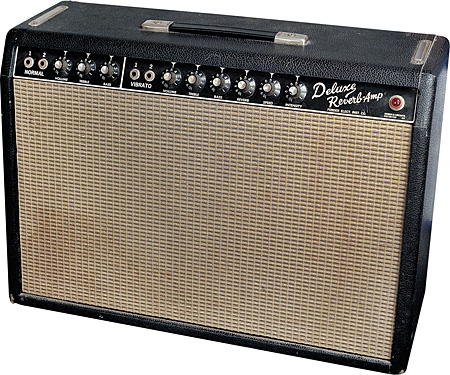 |
| Deluxe Reverb model AB763 |
 |
| 1965 Deluxe Reverb |
The handle on this amplifier was made of black reinforced vinyl with chrome glides.
This was the first year the amp came with the well known Fender badge and this one had a tail from the last “r” that went underneath the word “Fender.” The badge was mounted on the side of the grill.
 |
| 1963 Fender Deluxe Reverb |
A 12AT7 tube was used as a phase inverter. The rectifier was a GZ34 tube. The tremolo section was run by a 12AX7 and a 12AT7 was used as a reverb driver. This amp also had an adjustable bias potentiometer.
 |
| Original '65 Deluxe Reverb |
The Blackface Deluxe Reverb remained in the Fender line-up through 1967.
As you might recall, CBS purchased the Fender company in 1965, and part of the sale included a lot of left over stock so chances are if you have a Blackface Deluxe Reverb from that vintage it was more than likely a pre-CBS amplifier.
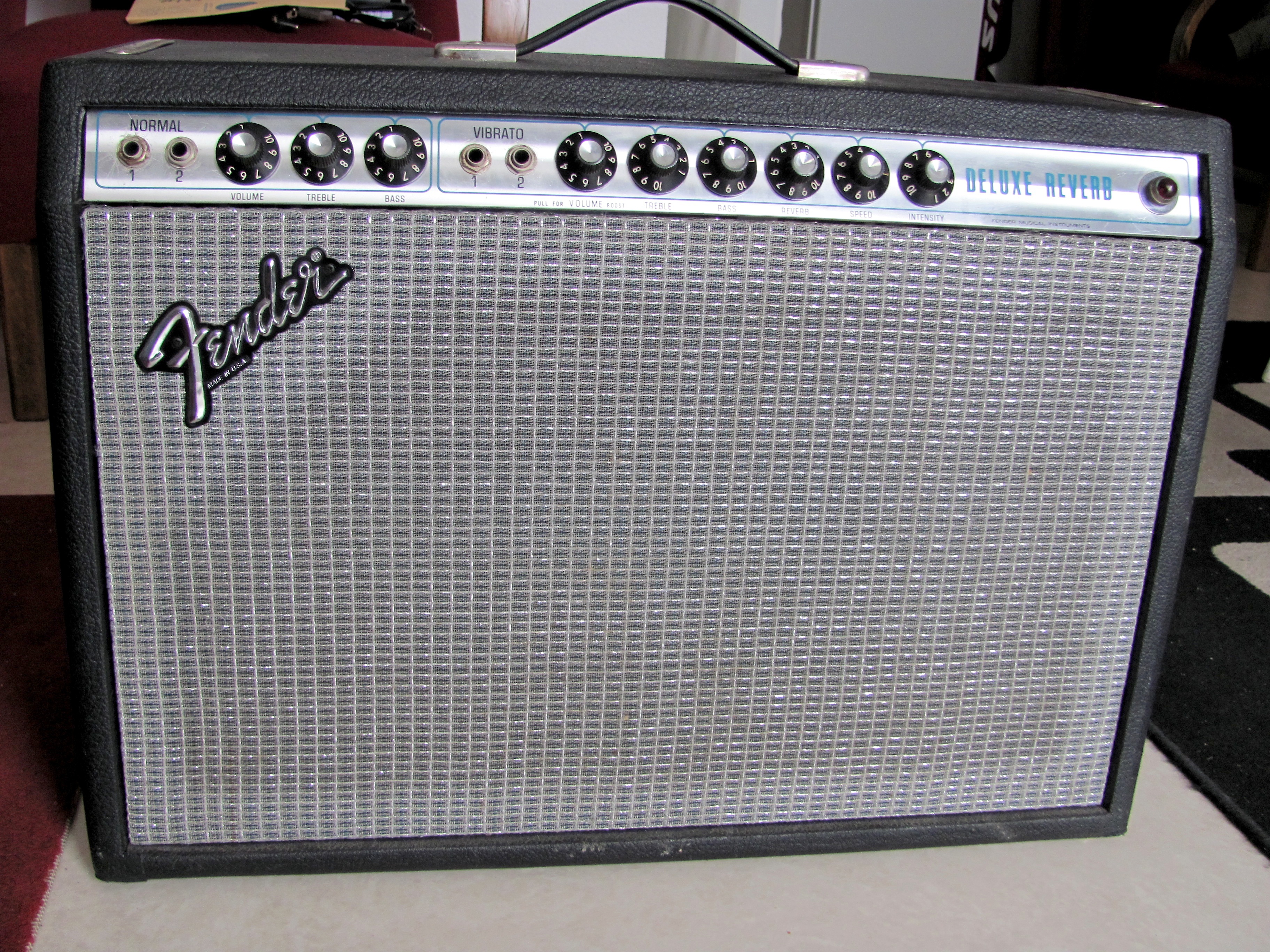 |
| 1968 Fender Deluxe Reverb |
Once again the cabinet was covered in black tolex. The front control panel had the same controls as the Blackface model and the twin channels remained. Although in 1977 the volume control on the Vibrato channel was changed from a standard potentiometer to one that had a dual function. You could pull it forward to activate a volume boost.
The facade for the control panel was now finished in translucent silver. Instead of the familiar Fender font stating “Deluxe Reverb”, the font used now was light blue block lettering.
The only change on the back panel was that the AC outlet was switched to a 3 prong version. The other controls remained the same as the Blackface model, except in 1979 a line out jack was added. The speaker was generally made by Oxford, however Fender also used Utah speakers.
 |
| '69 model with aluminum frame |
Starting in 1970 and lasting until 1975 the aluminum frame was no longer on the amp. Then in 1976 through the end of the run, in 1982, the grill cloth was made of a silver and orange woven material.
The amp retained the familiar Fender badge on the grill cloth and from 1968 through 1974 it had the “tail’. Sometime in 1974 the Fender badge was changed to a tailless version and this was the logo used until 1993 when Fender decided to recreate the “1965 Deluxe Reverb” and used the older badge with the tail.
The tubes in the Silverface Deluxe Reverb were virtually the same tubes used in the Blackface model with the exception of the rectifier, which was now a 5U4GB. The output on this model was still rated at 22 watts RMS.
 |
| 1980 Deluxe Reverb |
But the the grill cloth on the 1980 Deluxe Reverb changed back to the silver sparkle woven pattern. The Silverface Deluxe Reverb and its newer Blackface predecessor ended their run in 1982.
 |
| Deluxe Reverb II |
The production history of this amp is interesting, but first here is a little about the amp.
The circuit was completely redesigned. This amp had the ability to get the normal Fender-style clean sound, but it also came with a switchable mid-range voiced gain channel. This feature was designed to compete with competitive amps built during this era, such as Mesa Boogie (which interestingly started out as a Fender Princeton Reverb).
On the Deluxe Reverb II, no longer were there two different individual and separate channels. This model came with two totally different channels that incorporated the possibility of switching sounds.
Guitar players in the late 1970's had experimented with ways to utilize the both channels on their Fender amps to get different and overdriven sounds. The Rivera/Fender amps were what they were dreaming about.
 |
| Paul Rivera |
From outward appearance this amplifier looked pretty much like a Blackface Deluxe Reverb. The cabinet was covered in black tolex and the speaker baffle was covered in blue/grey sparkle grill cloth. The front panel was black with two instrument inputs.
The words Deluxe Reverb II, in the stylized Fender font were on the face-plate.
On the rear of the amp was a 3 prong electrical outlet, a 3-way “ground” switch which could be switched to the left, middle/off or right position, a speaker input, an external speaker input, two inputs for the amps pedals (channel switching and reverb), an input for reverb out and reverb in and a hum balance potentiometer, which was turned with a screwdriver. Tremolo was gone on this model.
 |
| Deluxe Reverb II replaced speaker |
The other 1/2 of the 7025 was used for reverb recovery and one other 7025 was used as the reverb driver. The rectifier was solid-state for this model. The bias was fixed and was not adjustable.
The Deluxe Reverb II and others in the Rivera series were special amps because these were the last of the amps made at the Fullerton California facility.
 |
| William Schults |
 |
| Bill Schultz and Bill Mendello |
 |
| Fender Fullerton Factory |
The Deluxe Reverb II and the other Paul Rivera designed amps ended their run in 1986. This would be the last of the Deluxe amplifiers until 1993 when Fender recreated the ‘65 Deluxe Reverb amplifier.
 |
| '65 Deluxe Reverb Reissue |
The '65 Deluxe Reverb was a very similar amplifier, especially in appearance, but the circuit board was modernized to a printed board and the speaker was now made by Eminence.
 |
| '68 Custom Deluxe Reverb reissue |
The two channels are marked Custom and Vintage.
The Vintage channel or what we think of as the reverb side has more of a Bassman style tone circuit, while the first channel, now marked Vintage has more of a vintage tone stack on the normal side. But both sides now share reverb and tremolo. The negative feedback loop was removed from the circuit so the amp has more bite and grit. The speaker in this model is a Celestion.

